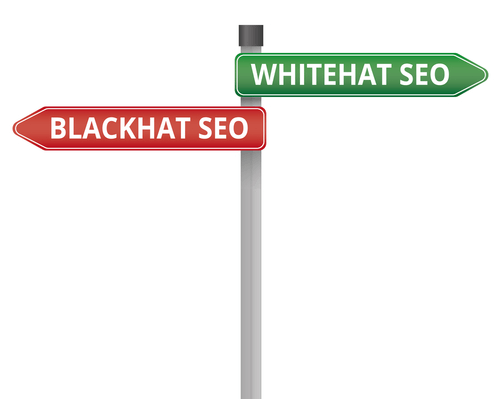Content Black Hat SEO Explained – 5 Techniques to Avoid
Anyone who works in SEO knows that it is an industry that keeps changing. There is a chance that what worked five years ago no longer works today. At worst, it may even be considered bad practice.
While it may seem tough to keep up with all the changes, there are a couple of golden rules that never seem to change in SEO. And that is to prioritize white hat SEO techniques and avoid black hat SEO techniques.
Although we will get into this more down below, white hat SEO can be surmised as Google’s approved techniques. However, black hat SEO can be surmised as bad practices meant to cheat the system.
If you have ever tried using black hat SEO techniques, you would have noted that they do work. But, only momentarily. You got in and got out quickly, with a handful of conversions. Overall, this just isn’t a good business practice if you’re looking for consistent conversions.
The true key to sustainable growth is using white hat SEO. While it may take longer to rank with these methods, the idea is that Google will eventually filter through the filth and find your beautiful website.
So, what are white hat and black hat SEO techniques?
Well, let’s have a look at both concepts and a handful of popular black hat techniques many webmasters are guilty of using.

What is White Hat SEO?
As mentioned above, white hat SEO refers to techniques that aim to improve your site’s rankings without impacting the site’s overall aim or integrity. So, the site remains authentic but uses SEO to improve its search rankings.
White hat SEO is generally considered to be Google’s suggested techniques, which can be surmised as follows:
- Write pages for humans.
- Create content that actually helps people. (One good question to ask yourself is whether your content would exist in the way that it does if there were no search engines).
- Make your website unique. Ask yourself: “Does my website have a unique selling point?”
- Don’t try to trick people with your content. Be transparent!
While some may believe that these guidelines are a little broad, the clear thread surrounding this advice is that you should create content you as a person would want to consume. In addition, you should care about your content.
What is Black Hat SEO?
Black hat SEO refers to a set of techniques webmasters use to trick search engines into ranking their content. While this content is great for quick returns, it is not good for longevity.
With regards to fallout when using these techniques, the best-case scenario is that your site simply stops ranking. However, worst-case scenario is that your site gets a penalty or a specific page that gets caught is deindexed.
Black hat SEO techniques include:
- Cloaking
- Keyword stuffing
- Poor quality content
- Building private link networks
- Paid links
- Link farms
- Abusing structured data (for example, creating fake reviews)
- Blog comment spam
While there are quick gains with black hat SEO, the cons far outweigh the pros. You could permanently damage your site’s reputation should Google decide to take action.

5 Common Black Hat SEO Content Techniques
Sometimes, the lines between black hat SEO and white hat SEO get a bit blurred. What was once a white hat practice is bastardized and turned into a black hat practice. Here are some areas where a lot of webmasters tend to go wrong from a content perspective:
1. Performing Bad Keyword Research
Nowadays, there are hundreds of different avenues through which to get a list of keywords people use to search for particular topics. SEMrush, Ahrefs, and Google Keyword Planner are only a handful of databases that provide such services.
However, while these tools give us an indicator of what the potential search volume of a keyword may be, it is important to note a few things about this data.
- The stated search volume is an estimation of the actual search volume. For example, the term “iPhone” has a search volume of 731,000 on Ahrefs.com, a volume of 1.2 million on SEMrush, and an undefined volume on Web CEO (meaning that it is ridiculously large). Which is the right answer though?
- Then, as discussed recently, this volume is not always an indicator of how many people will click on your site should you rank well for that particular keyword. Search volume is not the same as clicks per search.
- A high search volume keyword doesn’t equate to conversions if you are selling a product. And, this boils down to the fact that you may not be analyzing user intent when you read a keyword (which brings us to the next point).
2. Ignoring User Intent
Ignoring user intent goes hand in hand with bad keyword research. Just because a keyword has a high search volume or is somewhat related to the topic you want to write about doesn’t mean that you should use it.
When performing your keyword research, you should be analyzing each and every keyword you use in your content. We have referenced this concept in several of our blogs regarding creating quality content for the user.
If you don’t fully understand what a search term means or how it may relate to your content, then research it. If it becomes abundantly clear that it does not relate to your topic, do not use it. You should never use your keyword list as a checklist.

3. Focusing on “Ideal” Keyword Density Too Much – Keyword Stuffing
Although many webmasters try to put numbers on metrics such as keyword density, it is not possible. Optimal keyword density is something that shifts from topic to topic and keyword to keyword.
A tool might tell you that you are using your main keyword too much. But the forced removal thereof makes your content unsuitable to readers, which then destroys your content. Similarly, you could be trying to include more keywords to reach a certain target and then get penalized for stuffing.
Often, it is keyword placement rather than density that affects rankings. Trying to meet certain specifications creates situations in which you perhaps overuse or underuse key terms and phrases. In either situation, you hurt your chances of ranking and hurt the quality of your content.
Your overall aim when creating content should be to create good content for the user, which we get into in the next heading.
4. Writing for Bots, Not Users
A lot of webmasters tend to forget that keywords are meant to accentuate your content. You are not supposed to create your content around a keyword. Rather you are meant to look at how keywords can fit into something you already want to create or know you should be creating.
Some webmasters will repeat certain phrases or keywords for the purposes of ranking. And, in doing so, they make content that is difficult to read. If your writing is unnatural for the purposes of ranking, it is going to have the opposite effect.
Remember that you are meant to write for humans and not for search engines. Trying to trick the search engine highlights to the bots that you are not being genuine in your content. Therefore, there is no reason to recommend it because it probably won’t help anyone.

5. Spinning Content
Spinning content usually refers to a writing technique in which a person rewrites an article so that the meaning remains the same but it appears to be different to both the bot and the user. Nowadays, the technique is mostly associated with AIs that rewrite gibberish using certain keywords, but human writers can spin content too.
The issue with spinning content is that you are not creating new content with value. The reader will learn nothing new from reading your article and the original. If anything, if you didn’t understand the concepts you were trying to spin, you might even provide them with misinformation.
Additionally, writing an article that parrots what another says in other words is likely to fail simply due to the age of the original piece. Google will always know that your article came afterwards, so you have little chance of leapfrogging the original.
Conclusion
While the short-term gains that black hat SEO techniques promise may seem tempting, they are not the path to sustainable growth and conversions. Always look at your content critically and ask yourself whether it is something you would read. If not, then it may be time to have a look at your approach.
Remember that the best SEO approach is always to look at the user first and the bot second even if it is tempting to switch the two around.
Download our presentation on this topic here: Black Hat SEO Vs White Hat SEO


